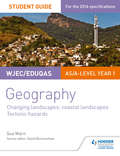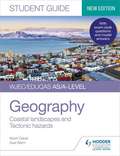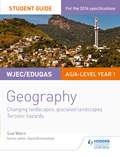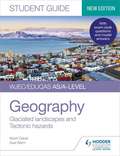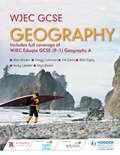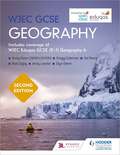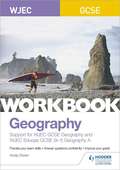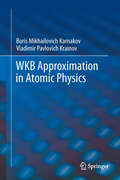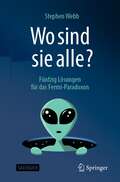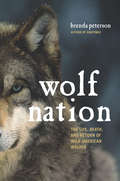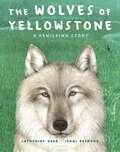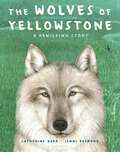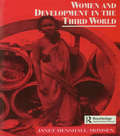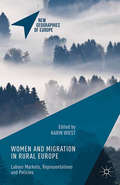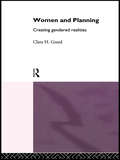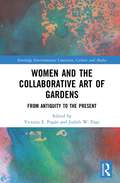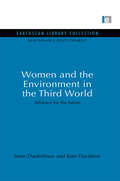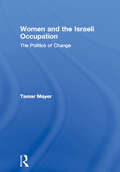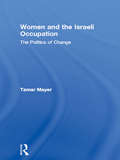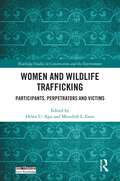- Table View
- List View
WJEC/Eduqas AS/A-level Geography Student Guide 2: Coastal Landscapes; Tectonic Hazards (PDF)
by Sue WarnExam Board: EduqasLevel: AS/A-levelSubject: GeographyFirst Teaching: September 2016First Exam: September 2017Reinforce students' geographical understanding throughout their course; clear topic summaries with sample questions and answers help students improve their exam technique and achieve their best.Written by a teacher with extensive examining experience, this guide:- Helps students identify what they need to know with a concise summary of the topics examined at AS and A-level- Consolidates understanding through assessment tips and knowledge-check questions- Offers opportunities for students to improve their exam technique by consulting sample graded answers to exam-style questions- Develops independent learning and research skills- Provides the content students need to produce their own revision notes
WJEC/Eduqas AS/A-level Geography Student Guide 2: Coastal landscapes and Tectonic hazards
by Kevin Davis Sue WarnWJEC/Eduqas AS/A-level Geography Student Guide 3: Glaciated Landscapes; Tectonic Hazards (PDF)
by Sue WarnReinforce students' geographical understanding throughout their course; clear topic summaries with sample questions and answers help students improve their exam technique and achieve their best.Written by a teacher with extensive examining experience, this guide:- Helps students identify what they need to know with a concise summary of the topics examined at AS and A-level- Consolidates understanding through assessment tips and knowledge-check questions- Offers opportunities for students to improve their exam technique by consulting sample graded answers to exam-style questions- Develops independent learning and research skills- Provides the content students need to produce their own revision notes.
WJEC/Eduqas AS/A-level Geography Student Guide 3: Glaciated landscapes and Tectonic hazards
by Kevin Davis Sue WarnReinforce geographical understanding throughout the course with clear topic summaries and sample questions and answers to help your students target higher grades. Written by teachers with extensive examining experience and fully updated for 2020 by experienced teacher and author Kevin Davies, this Student Guide covers: - Eduqas A-level Component 1: Changing landscapes and changing places, Section A Glaciated landscapes- Eduqas A-level Component 3: Contemporary themes in geography, Section A Tectonic hazards - WJEC AS Unit 1 Changing landscapes, Section A Glaciated landscapes and Section B Tectonic hazards- WJEC A2 Unit 4 Contemporary themes in geography, Section A Tectonic hazards Our Student Guides are divided into two key sections Content Guidance and Questions and Answers.Content Guidance will help your students to: - Identify key content for the exams with our concise coverage of topics- Reinforce your learning with bullet-list summaries at the end of each section- Test your knowledge with rapid-fire knowledge check questions & answersQuestions and Answers will help your students to:- Build understanding of the different question types- Find out what examiners are looking for with sample answers and commentary explaining why marks have been awarded
WJEC GCSE Geography
by Andy Leeder Alan Brown Gregg Coleman Bob Digby Glyn Owen Val DavisHelp your students develop enquiring minds as they learn the geographical knowledge and skills they need through the enquiries of the new OCR B specification which include and up-to-date case studies, a wide range of activities and exam-style questions developed to support and stretch students of all abilities.- Supports students of all abilities through differentiated activities including scaffolded questions and extension questions.- Highlights opportunities for fieldwork throughout the book, and includes guidance on carrying out fieldwork.- Develops students' geographical skills including activities and clear explanations of how to use mathematical and statistical skills.- Helps students gain confidence for the exam with a variety of exam-style practice questions at different levels, with tips on how to approach them.
WJEC GCSE Geography Second Edition
by Alan Brown Bob Digby Andy Leeder Andy Owen Glyn Owen Val Davis Gregg ColemanDevelop your students' subject knowledge and skills using the second edition of the WJEC GCSE (9-1) Geography A Student book. With modernised and engaging case studies, new practice questions help students as they progress through their GCSE, providing additional opportunities to practice higher tariff exam style questions. The new Key Terms boxes provide students with concise and easy to understand definitions of key geographical terms. - Contains coherent coverage of every core and optional theme in a single volume, with clear explanations of key concepts throughout- Engages and challenges students of all abilities with an exciting, thematic approach, brought to life by Welsh, UK and international place references- Improves students' ability to interpret, analyse and evaluate geographical information through practical, skills-focused activities that involve data, maps and photographs- Boosts candidates' confidence approaching examination by providing numerous learning opportunities for each assessed theme- Enables effective differentiation with enquiry tasks designed to stretch higher-ability students and encourage independent research
WJEC GCSE Geography Workbook (PDF)
by Andy OwenExam board: WJEC and WJEC Eduqas Level: GCSE Subject: Geography First teaching: September 2016 First exams: Summer 2018 Build, practise and improve exam skills throughout your WJEC / Eduqas A GCSE Geography course to boost confidence and grades in the final exams. Suitable for all abilities, this write-in workbook enables students to: - Understand how to approach, plan and structure exam responses, working through activities with step-by-step breakdowns and tips for every question type and every paper - Apply their newly-developed exam skills and existing geographical knowledge to exam-style questions that include mark allocations - Tackle the challenges of high-tariff questions and command words, with in-depth guidance and plenty of examples for 'how far do you agree' and 'to what extent' questions - Learn independently at home or in class, using the online answers to check their responses to exam-style questions This book covers the content of: - 2016 WJEC GCSE (A*-G) Geography specification regulated by Qualifications Wales - 2016 WJEC Eduqas GCSE (9-1) Geography A specification regulated by Ofqual
WKB Approximation in Atomic Physics
by Boris Mikhailovich Karnakov Vladimir Pavlovich KrainovThis book has evolved from lectures devoted to applications of the Wentzel - Kramers – Brillouin- (WKB or quasi-classical) approximation and of the method of 1/N −expansion for solving various problems in atomic and nuclear physics. The intent of this book is to help students and investigators in this field to extend their knowledge of these important calculation methods in quantum mechanics. Much material is contained herein that is not to be found elsewhere. WKB approximation, while constituting a fundamental area in atomic physics, has not been the focus of many books. A novel method has been adopted for the presentation of the subject matter, the material is presented as a succession of problems, followed by a detailed way of solving them. The methods introduced are then used to calculate Rydberg states in atomic systems and to evaluate potential barriers and quasistationary states. Finally, adiabatic transition and ionization of quantum systems are covered.
Wo sind sie alle?: Fünfzig Lösungen für das Fermi-Paradoxon
by Stephen WebbAllein in unserer Galaxie gibt es etwa eine Milliarde erdähnlicher Planeten. Im sichtbaren Universum finden sich etwa 200 Milliarden Galaxien. Liegt es daher nicht nahe, dass sich irgendwo da draußen eine Zivilisation entwickelt hat, die mindestens genauso fortgeschritten ist wie unsere eigene? Die schieren Zahlen verlangen fast danach. Aber: Wieso sind wir dann noch nicht auf Botschaften, Artefakte oder sonstige Hinweise auch nur einer einzigen außerirdischen Zivilisation gestoßen?In diesem Buch führt Stephen Webb durch fünfzig überzeugende und faszinierende Lösungen des berühmten Fermi-Paradoxons, die kurzweilig präsentiert zum Nachdenken und auch Schmunzeln anregen.
Wolf Nation: The Life, Death, and Return of Wild American Wolves (A Merloyd Lawrence Book)
by Brenda PetersonIn the tradition of Peter Matthiessen's Wildlife in America or Aldo Leopold, Brenda Peterson tells the 300-year history of wild wolves in America. It is also our own history, seen through our relationship with wolves. The earliest Americans revered them. Settlers zealously exterminated them. Now, scientists, writers, and ordinary citizens are fighting to bring them back to the wild. Peterson, an eloquent voice in the battle for twenty years, makes the powerful case that without wolves, not only will our whole ecology unravel, but we'll lose much of our national soul.
Wolf Nation: The Life, Death, and Return of Wild American Wolves (A Merloyd Lawrence Book)
by Brenda PetersonIn the tradition of Peter Matthiessen's Wildlife in America or Aldo Leopold, Brenda Peterson tells the 300-year history of wild wolves in America. It is also our own history, seen through our relationship with wolves. The earliest Americans revered them. Settlers zealously exterminated them. Now, scientists, writers, and ordinary citizens are fighting to bring them back to the wild. Peterson, an eloquent voice in the battle for twenty years, makes the powerful case that without wolves, not only will our whole ecology unravel, but we'll lose much of our national soul.
The Wolves of Yellowstone: A Rewilding Story
by Catherine BarrHere is the fascinating true story of the wolves who restored the ecosystem at Yellowstone National Park, written by Catherine Barr and illustrated by award-winner Jenni Desmond.In the 1930s, the last wolves disappeared from Yellowstone National Park. Without them, elk herds overran the plains. Bears starved, rabbit families shrunk, and birds flew away to new homes. Then plants and trees started to die off, too-even the flow of rivers was affected. Could the park be saved . . . by the wolves it had lost? After years of planning, in 1995 a team of experts was ready to find out. They carefully relocated fourteen wolves from the Canadian Rockies to Yellowstone. This is the story of their homecoming.Engaging, informative, and hopeful, The Wolves of Yellowstone shows us that every creature plays a role in sustaining a thriving ecosystem.
The Wolves of Yellowstone: A Rewilding Story
by Catherine BarrHere is the fascinating true story of the wolves who restored the ecosystem at Yellowstone National Park, written by Catherine Barr and illustrated by award-winner Jenni Desmond.In the 1930s, the last wolves disappeared from Yellowstone National Park. Without them, elk herds overran the plains. Bears starved, rabbit families shrunk, and birds flew away to new homes. Then plants and trees started to die off, too-even the flow of rivers was affected. Could the park be saved . . . by the wolves it had lost? After years of planning, in 1995 a team of experts was ready to find out. They carefully relocated fourteen wolves from the Canadian Rockies to Yellowstone. This is the story of their homecoming.Engaging, informative, and hopeful, The Wolves of Yellowstone shows us that every creature plays a role in sustaining a thriving ecosystem.
Women and Development in the Third World
by Janet MomsenFor all societies, the common denominator of gender is female subordination. For women of the Third World the effects of this position are worsened by economic crisis, the legacy of colonialism, as well as patriarchal attitudes and economic crises.Feminist critique has introduced the gender factor to development theory, arguing that the equal distribution of the benefits of economic development can only be achieved through a radical restructuring of the process of development. This important new book reviews both policy and practice in Latin America, Africa and Asia and raises thought-provoking questions concerning the role of development planning and the empowerment of women.
Women and Development in the Third World
by Janet MomsenFor all societies, the common denominator of gender is female subordination. For women of the Third World the effects of this position are worsened by economic crisis, the legacy of colonialism, as well as patriarchal attitudes and economic crises.Feminist critique has introduced the gender factor to development theory, arguing that the equal distribution of the benefits of economic development can only be achieved through a radical restructuring of the process of development. This important new book reviews both policy and practice in Latin America, Africa and Asia and raises thought-provoking questions concerning the role of development planning and the empowerment of women.
Women and Migration in Rural Europe: Labour Markets, Representations and Policies (New Geographies of Europe)
by Karin WiestFundamental societal changes in the globalising European countryside impact women's migration decisions. The chapters in this volume represent diverse attempts to explain women's movements from rural areas, taking prevailing labour market conditions as well as gender relations into account. Utilising empirical findings from countries including Austria, Germany, Hungary, Poland, Romania and Spain, this collection particularly aims to build bridges between research following the 'cultural turn' and functionalist explanations which refer to material and practiced ruralities. The international range of contributors to Women and Migration in Rural Europe focus on societal constructions of gender and rurality, and in doing so, address various female perspectives on rural life. The analysis of the different working and living conditions in different parts of rural Europe reveals distinct obstacles but also prospects for young women. Importantly, the book includes policy implications with respect to the challenges of demographic change, questions of gender equality and women's contribution to rural development.
Women and Planning: Creating Gendered Realities
by Clara H. GreedPlanning is currently a male profession, but an analysis of a century of town planning reveals this to be a new development; women have been central to the planning movement since it began. Women and Planning is the first comprehensive history and analysis of women and the planning movement, covering the philosophical, practical and policy dimensions of `planning for women'. Beyond the marginalization of women, modern, scientific planning hides a story of past links with eugenics, colonialism, artistic, utopian and religious movements and the occult. Central to the discussion is the questioning of how male planners have rewritten planning in their own image, projecting patriarchal assumptions in their creation of `urban realities'. Issues of class, sexuality, ethnicity and disability are raised by the fundamental question of `Who is being planned for?'
Women and Planning: Creating Gendered Realities
by Clara H. GreedPlanning is currently a male profession, but an analysis of a century of town planning reveals this to be a new development; women have been central to the planning movement since it began. Women and Planning is the first comprehensive history and analysis of women and the planning movement, covering the philosophical, practical and policy dimensions of `planning for women'. Beyond the marginalization of women, modern, scientific planning hides a story of past links with eugenics, colonialism, artistic, utopian and religious movements and the occult. Central to the discussion is the questioning of how male planners have rewritten planning in their own image, projecting patriarchal assumptions in their creation of `urban realities'. Issues of class, sexuality, ethnicity and disability are raised by the fundamental question of `Who is being planned for?'
Women and the Collaborative Art of Gardens: From Antiquity to the Present (Routledge Environmental Literature, Culture and Media)
by Victoria E. Pagán Judith W. PageWomen and the Collaborative Art of Gardens explores the garden and its agency in the history of the built and natural environments, as evidenced in landscape architecture, literature, art, archaeology, history, photography, and film. Throughout the book, each chapter centers the act of collaboration, from garden clubs of the early twentieth century as powerful models of women’s leadership, to the more intimate partnerships between family members, to the delicate relationship between artist and subject. Women emerge in every chapter, whether as gardeners, designers, owners, writers, illustrators, photographers, filmmakers, or subjects, but the contributors to this dynamic collection unseat common assumptions about the role of women in gardens to make manifest the significant ways in which women write themselves into the accounts of garden design, practice, and history. The book reveals the power of gardens to shape human existence, even as humans shape gardens and their representations in a variety of media, including brilliantly illuminated manuscripts, intricately carved architectural spaces, wall paintings, black and white photographs, and wood cuts. Ultimately, the volume reveals that gardens are best apprehended when understood as products of collaboration. The book will be of interest to scholars and students of gardens and culture, ancient Rome, art history, British literature, medieval France, film studies, women’s studies, photography, African American Studies, and landscape architecture.
Women and the Collaborative Art of Gardens: From Antiquity to the Present (Routledge Environmental Literature, Culture and Media)
Women and the Collaborative Art of Gardens explores the garden and its agency in the history of the built and natural environments, as evidenced in landscape architecture, literature, art, archaeology, history, photography, and film. Throughout the book, each chapter centers the act of collaboration, from garden clubs of the early twentieth century as powerful models of women’s leadership, to the more intimate partnerships between family members, to the delicate relationship between artist and subject. Women emerge in every chapter, whether as gardeners, designers, owners, writers, illustrators, photographers, filmmakers, or subjects, but the contributors to this dynamic collection unseat common assumptions about the role of women in gardens to make manifest the significant ways in which women write themselves into the accounts of garden design, practice, and history. The book reveals the power of gardens to shape human existence, even as humans shape gardens and their representations in a variety of media, including brilliantly illuminated manuscripts, intricately carved architectural spaces, wall paintings, black and white photographs, and wood cuts. Ultimately, the volume reveals that gardens are best apprehended when understood as products of collaboration. The book will be of interest to scholars and students of gardens and culture, ancient Rome, art history, British literature, medieval France, film studies, women’s studies, photography, African American Studies, and landscape architecture.
Women and the Environment in the Third World: Alliance for the future (Sustainable Development Set)
by Irene Dankelman Joan Davidson'This book ... should be issued to grass-root organisations everywhere' Doris Lessing, The New Scientist 'It is must reading for government planners, environmentalists and the ordinary layman' Asia Week Women in the Third World play the major role in managing natural resources. They are also the first and hardest hit by environmental mismanagement, yet they are neither consulted nor taken into account by development strategists. lrene Dankelman and Joan Davidson provide a clear account of the problems faced by women in the management of land, water, forests, energy and human settlements. They also describe the lack of response from international organizations. With the help of well-documented case studies they describe the ways in which women can organize to meet environmental, social and economic challenges. Originally published in 1988
Women and the Environment in the Third World: Alliance for the future (Sustainable Development Set)
by Irene Dankelman Joan Davidson'This book ... should be issued to grass-root organisations everywhere' Doris Lessing, The New Scientist 'It is must reading for government planners, environmentalists and the ordinary layman' Asia Week Women in the Third World play the major role in managing natural resources. They are also the first and hardest hit by environmental mismanagement, yet they are neither consulted nor taken into account by development strategists. lrene Dankelman and Joan Davidson provide a clear account of the problems faced by women in the management of land, water, forests, energy and human settlements. They also describe the lack of response from international organizations. With the help of well-documented case studies they describe the ways in which women can organize to meet environmental, social and economic challenges. Originally published in 1988
Women and the Israeli Occupation: The Politics of Change (Routledge International Studies of Women and Place)
by Tamar MayerThe state of Israel and the Palestinian nation are at a monumental juncture in their histories. Both have a chance to claim a new future but more than a quarter of a century of occupation has had significant social, political, economic, cultural, psychological and moral ramifications for Israeli and Palestinian men and women.Women and the Israeli Occupation analyses the impact of the occupier/occupied dichotomy on the lives of Palestinian, Israeli Palestinian, and Israeli Jewish women. The book argues that the Occupation has exposed internal conflicts, challenging social structures within all three societies, but has also reinforced existing loyalties as Palestinian and Jewish women have moved into public political action and worked together to end the Occupation. It suggests that although military occupation is not colonialism, there are many similarities in the Israeli/Palestinian case.
Women and the Israeli Occupation: The Politics of Change (Routledge International Studies of Women and Place)
by Tamar MayerThe state of Israel and the Palestinian nation are at a monumental juncture in their histories. Both have a chance to claim a new future but more than a quarter of a century of occupation has had significant social, political, economic, cultural, psychological and moral ramifications for Israeli and Palestinian men and women.Women and the Israeli Occupation analyses the impact of the occupier/occupied dichotomy on the lives of Palestinian, Israeli Palestinian, and Israeli Jewish women. The book argues that the Occupation has exposed internal conflicts, challenging social structures within all three societies, but has also reinforced existing loyalties as Palestinian and Jewish women have moved into public political action and worked together to end the Occupation. It suggests that although military occupation is not colonialism, there are many similarities in the Israeli/Palestinian case.
Women and Wildlife Trafficking: Participants, Perpetrators and Victims (Routledge Studies in Conservation and the Environment)
by Helen U. AguThis volume examines women and wildlife trafficking via a bespoke collection of narratives, case studies and theoretical syntheses from diverse voices and disciplines. Wildlife trafficking has been documented in over one hundred and twenty countries around the world. While species extinction and animal abuse are major problems, wildlife trafficking is also associated with corruption, national insecurity, spread of zoonotic disease, undercutting sustainable development investments and erosion of cultural resources among others. The role of women in wildlife trafficking has remained woefully under-addressed, with scientists and policymakers failing to consider the important causes and consequences of the gendered dimensions of wildlife trafficking. Although the roles of women in wildlife trafficking are mostly unknown, they are not unknowable. This volume helps fill this lacuna by examining the roles and experiences of women with case studies drawn from across the world, including Mexico, Cameroon, the Central African Republic, South Africa and Norway. Women can be wildlife trafficking preventors, perpetrators, and pawns; their roles in both facilitating wildlife trafficking are considered from both a supply and a demand viewpoint. The first half of the book assesses the state of science, offering four different perspectives on how women and wildlife trafficking can be studied or evaluated. The second half of the book profiles diverse case studies from around the world, offering context-specific insight about on-the-ground activities associated with women and wildlife trafficking. This book will be of great interest to students and scholars of wildlife crime, conservation, gender studies, green criminology and environmental law. It will also be of interest to NGOs and policymakers working to improve efficacy of efforts targeting wildlife crime, the illegal wildlife trade, and conservation more broadly.
